module 2 Environmental Indicators and Sustainability
As we study the way humans have altered the natural world, it is important to have techniques for measuring and quantifying human impact. Environmental indicators allow us to assess the impact of humans on Earth. The use of these indicators help us determine whether or not the quality of the natural environment is improving and inform discussions on the sustainability of humans on the planet.
Learning Objectives
After reading this module you should be able to
identify key environmental indicators and their trends over time.
define sustainability and explain how it can be measured using the ecological footprint.
Environmental scientists monitor natural systems for signs of stress
Ecosystem services The processes by which life-
One critical question that environmental scientists investigate is whether the planet’s natural life-
Environmental indicator An indicator that describes the current state of an environmental system.
To describe the health and quality of natural systems, environmental scientists use environmental indicators. Just as body temperature and heart rate can indicate whether a person is healthy or sick, environmental indicators describe the current state of an environmental system. These indicators do not always tell us what is causing a change, but they do tell us when we might need to look more deeply into a particular issue. Environmental indicators provide valuable information about natural systems on both small and large scales. Some of these indicators and the chapters in which they are covered are listed in TABLE 2.1.
In this book we will focus on the five global-
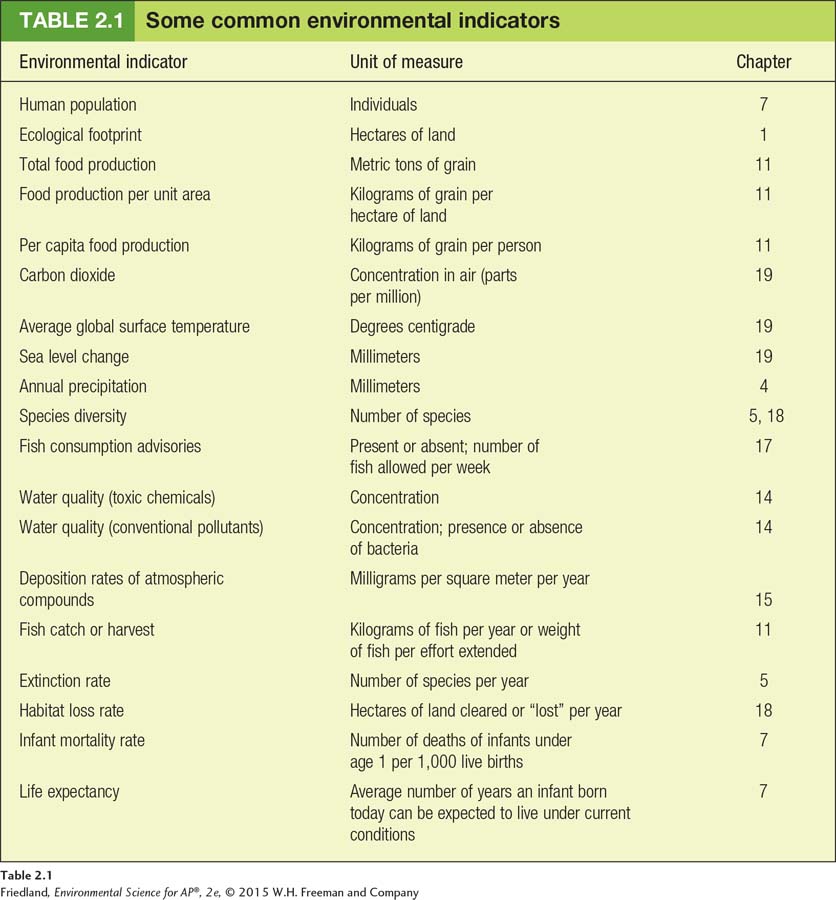
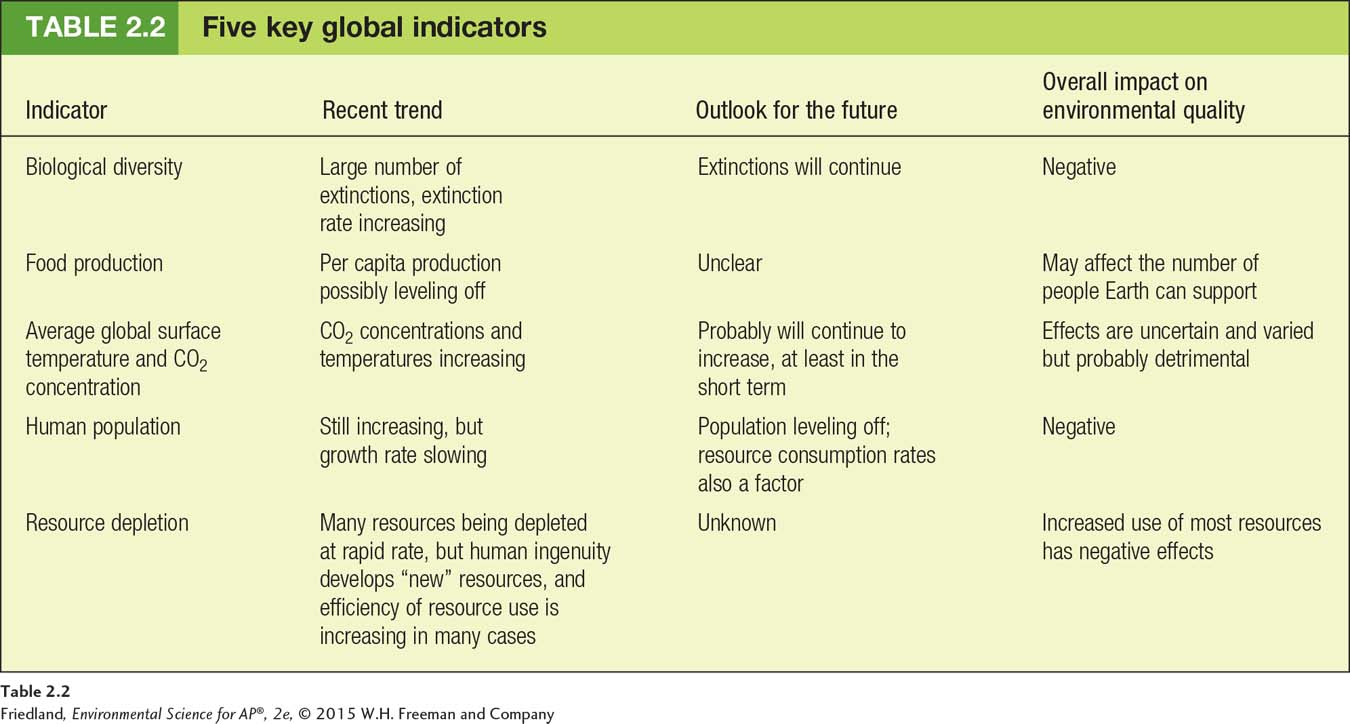
Biological Diversity
Biodiversity The diversity of life forms in an environment.

Biological diversity, or biodiversity, is the diversity of life forms in an environment. It exists on three scales: ecosystem, species, and genetic, illustrated in FIGURE 2.1. Each level of biodiversity is an important indicator of environmental health and quality.
Genetic Diversity
Genetic diversity A measure of the genetic variation among individuals in a population.
Genetic diversity is a measure of the genetic variation among individuals in a population. Populations with high genetic diversity are better able to respond to environmental change than populations with lower genetic diversity. For example, if a population of fish possesses high genetic diversity for disease resistance, at least some individuals are likely to survive whatever diseases move through the population. If the population declines in number, however, the amount of genetic diversity it can possess is also reduced, and this reduction increases the likelihood that the population will decline further when exposed to a disease.
Species Diversity
Species A group of organisms that is distinct from other groups in its morphology (body form and structure), behavior, or biochemical properties.
A species is defined as a group of organisms that is distinct from other groups in its morphology (body form and structure), behavior, or biochemical properties. Individuals within a species can breed and produce fertile offspring. Scientists have identified and cataloged approximately 2 million species on Earth. Estimates of the total number of species on Earth range between 5 million and 100 million, with the most common estimate at 10 million. This number includes a large array of organisms with a multitude of sizes, shapes, colors, and roles.
Species diversity The number of species in a region or in a particular type of habitat.
Species diversity indicates the number of species in a region or in a particular type of habitat. Scientists have observed that ecosystems with more species—
Speciation The evolution of new species.
Background extinction rate The average rate at which species become extinct over the long term.
Environmental scientists often focus on species diversity as a critical environmental indicator. The number of frog species, for example, is used as an indicator of regional environmental health because frogs are exposed to both the water and the air in their ecosystem. A decrease in the number of frog species in a particular ecosystem may be an indicator of environmental problems there. Species losses in several ecosystems can indicate environmental problems on a larger scale. Not all species losses are indicators of environmental problems, however. Species arise and others go extinct as part of the natural evolutionary process. The evolution of new species, known as speciation, typically happens very slowly—
Under conditions of environmental change or biological stress, species may go extinct faster than new ones evolve. Some scientists estimate that more than 1,000 species are currently going extinct each year—
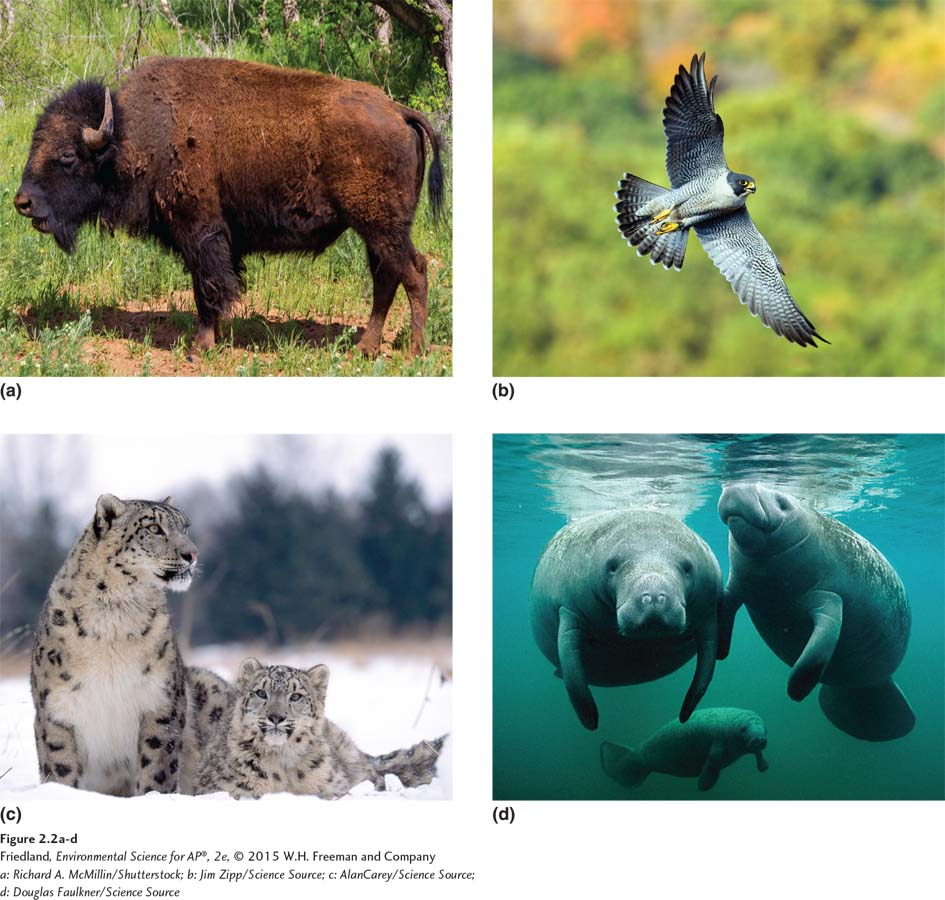
Ecosystem Diversity
Ecosystem diversity is a measure of the diversity of ecosystems or habitats that exist in a given region. A greater number of healthy and productive ecosystems means a healthier environment overall. As an environmental indicator, the current loss of biodiversity tells us that natural systems are facing strains unlike any in the recent past. We will look at this important topic in greater detail in Chapters 5 and 18.
Some measures of biodiversity are given in terms of land area, so becoming familiar with measurements of land area is important to understanding them. A hectare (ha) is a unit of area used primarily in the measurement of land. It represents 100 meters by 100 meters. In the United States we measure land area in terms of square miles and acres. However, the rest of the world measures land in hectares. “Do the Math: Converting Between Hectares and Acres” shows you how to do the conversion.

Food Production
The second of our five global indicators is food production: our ability to grow food to nourish the human population. Just as a healthy ecosystem supports a wide range of species, a healthy soil supports abundant and continuous food production. Food grains such as wheat, corn, and rice provide more than half the calories and protein humans consume. Still, the growth of the human population is straining our ability to grow and distribute adequate amounts of food.
In the past we have used science and technology to increase the amount of food we can produce on a given area of land. World grain production has increased fairly steadily since 1950 as a result of expanded irrigation, fertilization, new crop varieties, and other innovations. At the same time, worldwide production of grain per person, also called per capita world grain production, has leveled off. FIGURE 2.3 shows what might be a slight downward trend in wheat production since about 1985.
In 2008, food shortages around the world led to higher food prices and even riots in some places. Why did this happen? The amount of grain produced worldwide is influenced by many factors. These factors include climatic conditions, the amount and quality of land under cultivation, irrigation, and the human labor and energy required to plant, harvest, and bring the grain to market. Grain production is not keeping up with population growth because in some areas the productivity of agricultural ecosystems has declined as a result of soil degradation, crop diseases, and unfavorable weather conditions such as drought or flooding. In addition, demand is outpacing supply. While the rate of human population growth has outpaced increases in food production, humans currently use more grain to feed livestock than they consume themselves. Finally, some government policies discourage food production by making it more profitable for land to remain uncultivated or by encouraging farmers to grow crops for fuels such as ethanol and biodiesel instead of food.
Will there be sufficient grain to feed the world’s population in the future? In the past, whenever a shortage of food has loomed, humans have discovered and employed technological or biological innovations to increase production. However, these innovations often put a strain on the productivity of the soil. If we continue to overexploit the soil, its ability to sustain food production may decline dramatically. We will take a closer look at soil quality in Chapter 8 and food production in Chapter 11.
Average Global Surface Temperature and Carbon Dioxide Concentrations
We have seen that biodiversity and abundant food production are necessary for life. One of the things that makes them possible is a stable climate. Earth’s temperature has been relatively constant since the earliest forms of life began, about 3.5 billion years ago. The temperature of Earth allows the presence of liquid water, which is necessary for life.
Greenhouse gases Gases in Earth’s atmosphere that trap heat near the surface.
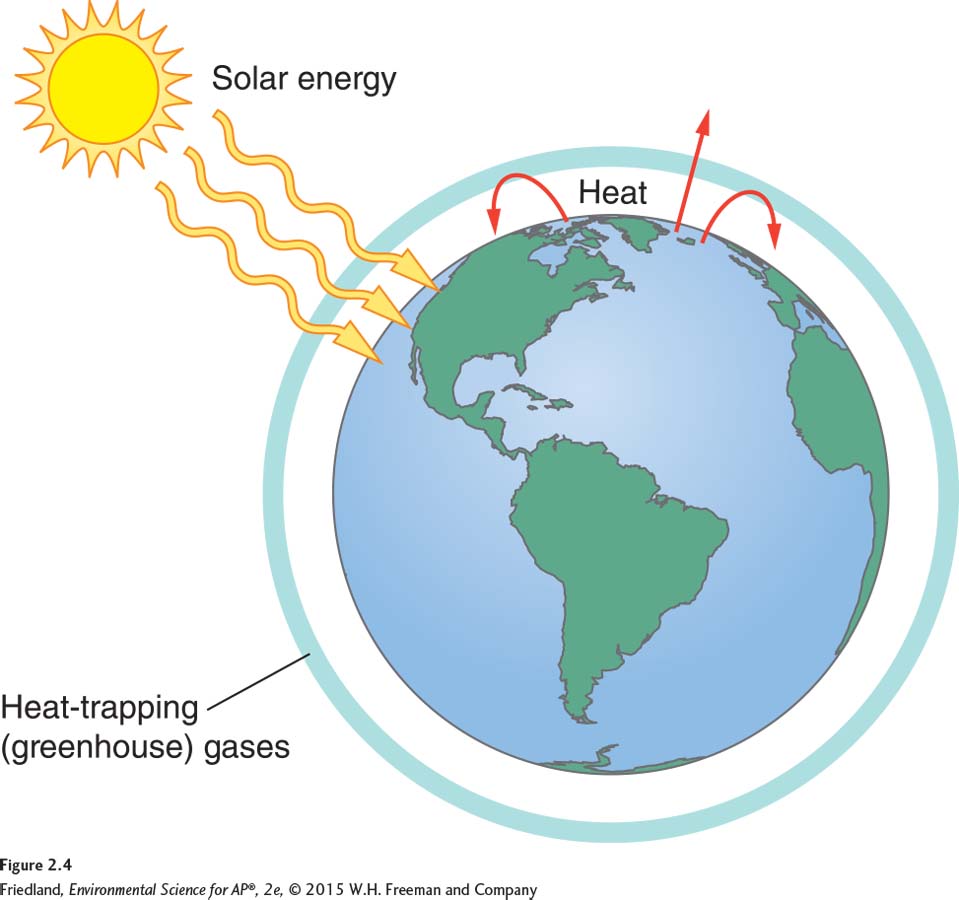
What keeps Earth’s temperature so constant? As FIGURE 2.4 shows, our thick planetary atmosphere contains many gases. Some of these atmospheric gases, known as greenhouse gases, trap heat near Earth’s surface. The most important greenhouse gas is carbon dioxide (CO2). During most of the history of life on Earth, greenhouse gases have been present in the atmosphere at fairly constant concentrations for relatively long periods. They help keep Earth’s surface within the range of temperatures at which life can flourish.
Anthropogenic Derived from human activities.
In the past 2 centuries, however, the concentrations of CO2 and other greenhouse gases in the atmosphere have risen. Today, atmospheric CO2 concentrations are greater than 400 parts per million (ppm). During roughly the same period, as the graph in FIGURE 2.5 shows, while global temperatures have fluctuated considerably, they have displayed an overall increase. (Note that this graph has two y axes. See the appendix “Reading Graphs” if you’d like to learn more about reading a graph like this one.) Many scientists believe that the increase in atmospheric CO2 during the last two centuries is anthropogenic—that is, the increase is derived from human activities. The two major sources of anthropogenic CO2 are the combustion of fossil fuels and the net loss of forests and other habitats that would otherwise take up and store CO2 from the atmosphere. We will discuss climate in Chapter 4 and global climate change in Chapter 19.
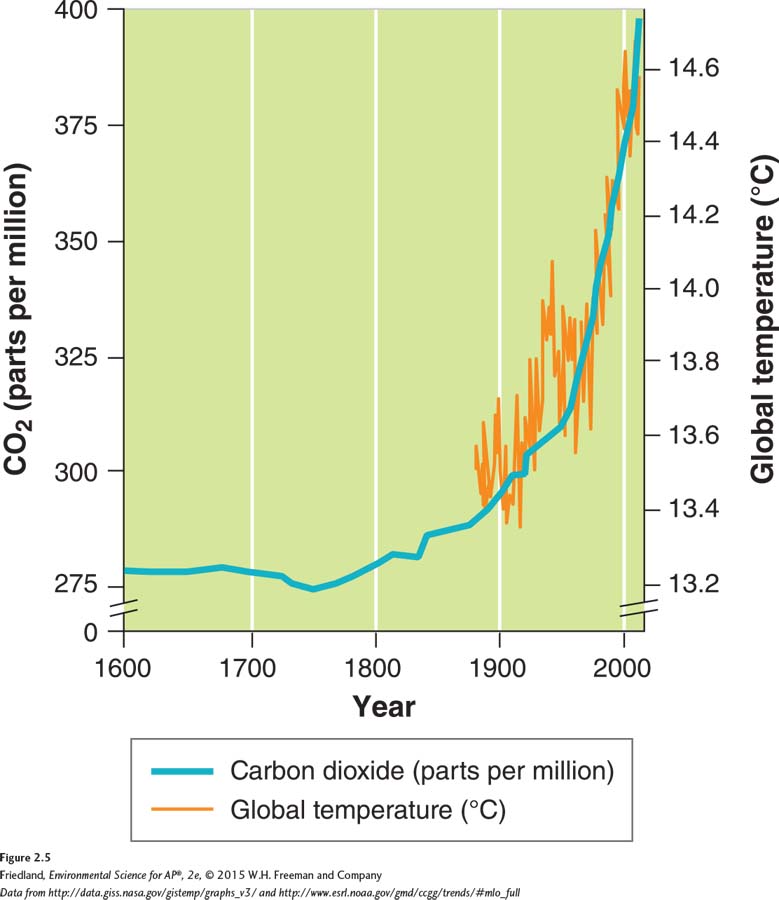
Human Population
In addition to biodiversity, food production, and global surface temperature, the size of the human population can tell us a great deal about the health of our global environment. The human population is currently 7.2 billion and growing. The increasing world population places additional demands on natural systems, since each new person requires food, water, and other resources. In any given 24-

Can the planet sustain so many people (FIGURE 2.6)? Even if the human population eventually stops growing, the billions of additional people will create a greater demand on Earth’s finite resources, including food, energy, and land. Unless humans work to reduce these pressures, the human population will put a rapidly growing strain on natural systems for at least the first half of this century. We discuss human population issues in Chapter 7.
Resource Depletion
Natural resources provide the energy and materials that support human civilization but, as the human population grows, the resources necessary for our survival become increasingly depleted. In addition, extracting these natural resources can affect the health of our environment in many ways. Pollution and land degradation caused by mining, waste from discarded manufactured products, and air pollution from fossil fuel combustion are just a few of the negative environmental consequences of resource extraction and use.
Some natural resources, such as coal, oil, and uranium, are finite and cannot be renewed or reused. Others, such as aluminum or copper, also exist in finite quantities but can be used multiple times through reuse or recycling. Renewable resources, such as timber, can be grown and harvested indefinitely, but in some locations these resources are being used faster than they can be naturally replenished. “Do the Math: Rates of Forest Clearing” on page 14 provides an opportunity to calculate rates of one type of resource depletion.
Sustaining the global human population requires vast quantities of resources. However, in addition to the total amounts of resources used by humans, we must consider per capita resource use.
Development Improvement in human well-
Patterns of resource consumption vary enormously among nations depending on their level of development. What exactly do we mean by development? Development is defined as improvement in human well-
According to the United Nations Development Programme, people in developed nations—
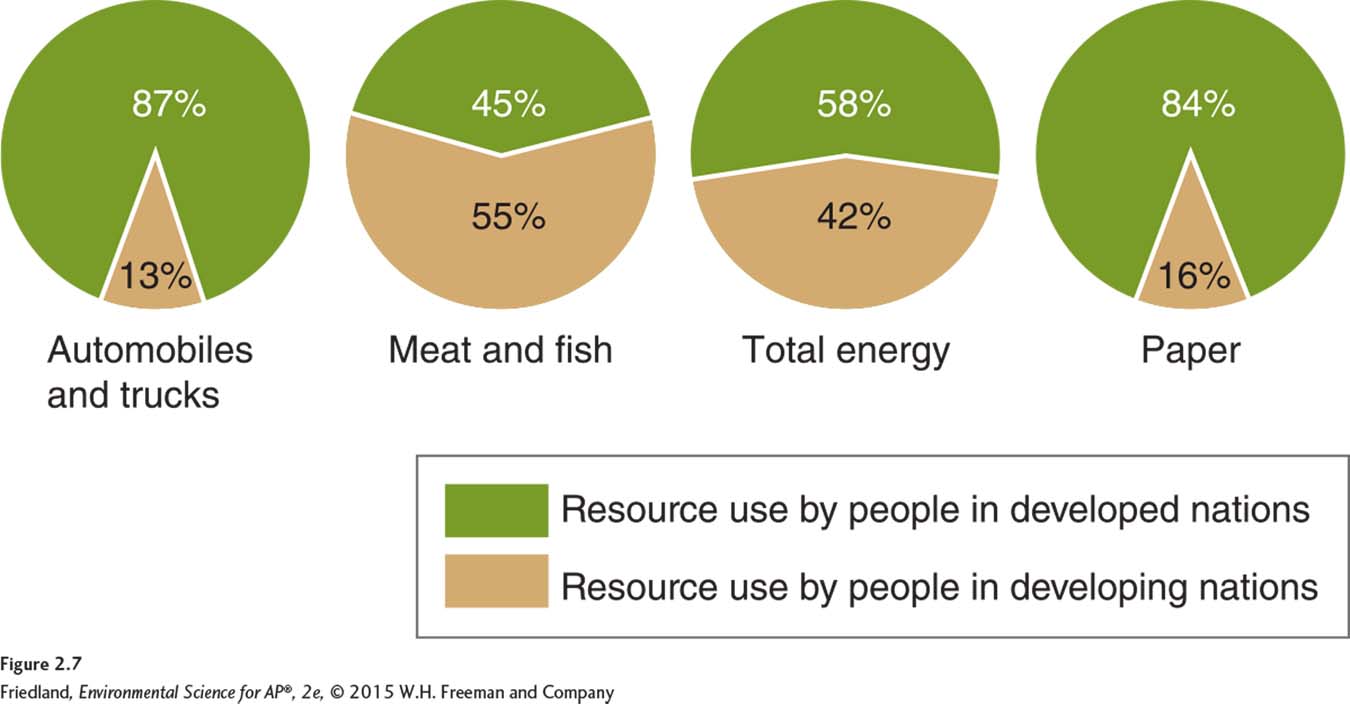
So while it is true that a larger human population has greater environmental impacts, a full evaluation requires that we look at economic development and consumption patterns as well. We will take a closer look at resource depletion and consumption patterns in Chapters 7, 12, and 13.
Human well-being depends on sustainable practice
Sustainability Living on Earth in a way that allows humans to use its resources without depriving future generations of those resources.
The five key environmental indicators that we have just discussed help us analyze the health of the planet. We can use this information to guide us toward sustainability, by which we mean living on Earth in a way that allows us to use its resources without depriving future generations of those resources. Many scientists maintain that achieving sustainability is the single most important goal for the human species. It is also one of the most challenging tasks we face.
The Impact of Consumption on the Environment
We have seen that people living in developed nations consume a far greater share of the world’s resources than do people in developing countries. What effect does this consumption have on our environment? It is easy to imagine a very small human population living on Earth without degrading its environment because there simply would not be enough people to do significant damage. Today, however, Earth’s population is 7.2 billion people and growing. Many environmental scientists ask how we will be able to continue to produce sufficient food, build needed infrastructure, and process pollution and waste. Our current attempts to sustain the human population have already modified many environmental systems. Can we continue our current level of resource consumption without jeopardizing the well-

Easter Island, in the South Pacific, provides a cautionary tale (FIGURE 2.8). This island, also called Rapa Nui, was once covered with trees and grasses. When humans settled the island many hundreds of years ago, they quickly multiplied in its hospitable environment. They cut down trees to build homes and to make canoes for fishing, but they overused the island’s soil and water resources. By the 1870s, almost all of the trees were gone. Without the trees to hold the soil in place, massive erosion occurred, and the loss of soil caused food production to decrease. While other forces, including diseases introduced by European visitors, were also involved in the destruction of the population, the unsustainable use of natural resources on Easter Island appears to be the primary cause for the collapse of its civilization.
Most environmental scientists believe that there are limits to the supply of clean air and water, nutritious foods, and other life-
Environmental systems must not be damaged beyond their ability to recover.
Renewable resources must not be depleted faster than they can regenerate.
Nonrenewable resources must be used sparingly.
Sustainable development Development that balances current human well-
Sustainable development is development that balances current human well-

Living sustainably means acting in a way such that activities that are crucial to human society can continue. It includes practices such as conserving and finding alternatives to nonrenewable resources as well as protecting the capacity of the environment to continue to supply renewable resources (FIGURE 2.9).
Consider iron, a nonrenewable resource derived from ore removed from the ground. Iron is the major constituent of steel, which we use to make many things, including automobiles, bicycles, and strong frames for tall buildings. Historically, our ability to smelt iron for steel limited our use of that resource, but as we have improved steel manufacturing technology, steel has become more readily available and the demand for it has grown. Because of this increased demand, our current use of iron is unsustainable. What would happen if we ran out of iron? While not too long ago the depletion of iron ore might have been a catastrophe, today we have developed materials that can substitute for certain uses of steel—
The example of iron leads us to a question that environmental scientists often ask: How do we determine the importance of a given resource? If we use up a resource such as iron for which substitutes exist, it is possible that the consequences will not be severe. However, if we are unable to find an alternative to the resource—
Defining Human Needs
We have seen that sustainable development requires us to determine how we can meet our current needs without compromising the ability of future generations to meet their own needs. Let’s look at how environmental science can help us achieve that goal. We will begin by defining needs.
If you have ever experienced an interruption of electricity to your home or school, you know how frustrating it can be. Without the use of lights, computers, televisions, air-
Biophilia Love of life.

But humans also have more complex needs. Many psychologists have argued that we require meaningful human interactions in order to live a satisfying life, and so a community of some sort might be considered a human need. Biologist Edward O. Wilson wrote that humans exhibit biophilia—that is, love of life—
The Ecological Footprint
We have begun to see the multitude of ways in which human activities affect the environment. As countries prosper, their populations use more resources. Economic development can sometimes improve environmental conditions. For instance, wealthier countries may have the resources to implement pollution controls and invest money to protect native species. So although people in developing countries do not consume the same quantity of resources as those in developed nations, they may be less likely to use environmentally friendly technologies or to have the financial resources to implement environmental protections.
How do we determine what lifestyles have the greatest environmental impact? This is an important question for environmental scientists if we are to understand the effects of human activities on the planet and develop sustainable practices. Calculating sustainability, however, is more difficult than one might think because we must consider the impacts of our activities and lifestyles on different aspects of our environment. We use land to grow food and to build structures on, and for parks and recreation. We require water for drinking, for cleaning, and for manufacturing products such as paper, and we need clean air to breathe. Yet these goods and services are all interdependent: Using or protecting one has an effect on the others. For example, using land for conventional agriculture may require water for irrigation, fertilizer to promote plant growth, and pesticides to reduce crop damage. This use of land reduces the amount of water available for human use: The plants consume it and the pesticides pollute it.
Ecological footprint A measure of how much an individual consumes, expressed in area of land.
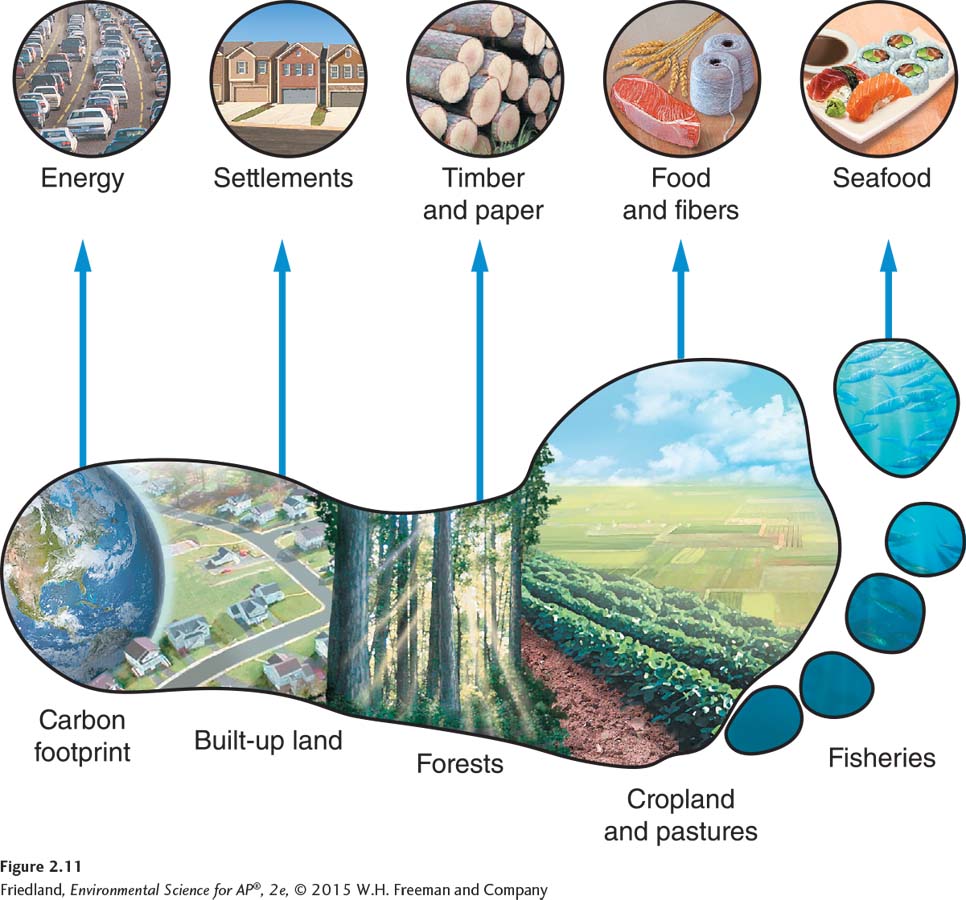
One method used to assess whether we are living sustainably is to measure the impact of a person or country on world resources. The tool many environmental scientists use for this purpose, the ecological footprint, was developed in 1995 by Professor William E. Rees and his graduate student Mathis Wackernagel. An individual’s ecological footprint is a measure of how much that person consumes, expressed in area of land—
Rees and Wackernagel maintained that if our lifestyle demands more land than is available, then we must be living unsustainably—